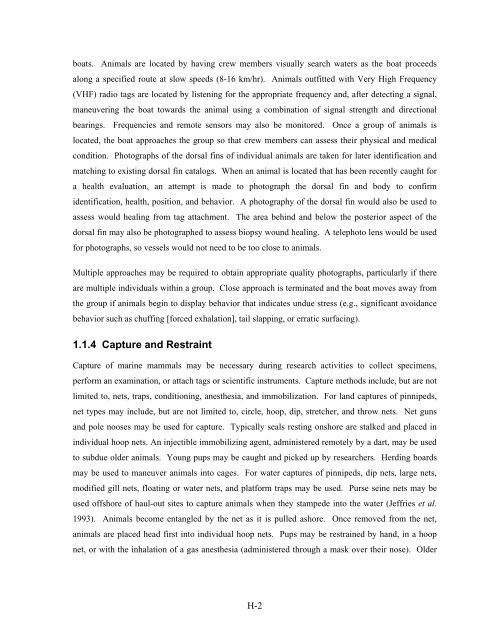Volume III, Appendices EM - National Marine Fisheries Service ...
Volume III, Appendices EM - National Marine Fisheries Service ...
Volume III, Appendices EM - National Marine Fisheries Service ...
Create successful ePaper yourself
Turn your PDF publications into a flip-book with our unique Google optimized e-Paper software.
oats. Animals are located by having crew members visually search waters as the boat proceeds<br />
along a specified route at slow speeds (8-16 km/hr). Animals outfitted with Very High Frequency<br />
(VHF) radio tags are located by listening for the appropriate frequency and, after detecting a signal,<br />
maneuvering the boat towards the animal using a combination of signal strength and directional<br />
bearings. Frequencies and remote sensors may also be monitored. Once a group of animals is<br />
located, the boat approaches the group so that crew members can assess their physical and medical<br />
condition. Photographs of the dorsal fins of individual animals are taken for later identification and<br />
matching to existing dorsal fin catalogs. When an animal is located that has been recently caught for<br />
a health evaluation, an attempt is made to photograph the dorsal fin and body to confirm<br />
identification, health, position, and behavior. A photography of the dorsal fin would also be used to<br />
assess would healing from tag attachment. The area behind and below the posterior aspect of the<br />
dorsal fin may also be photographed to assess biopsy wound healing. A telephoto lens would be used<br />
for photographs, so vessels would not need to be too close to animals.<br />
Multiple approaches may be required to obtain appropriate quality photographs, particularly if there<br />
are multiple individuals within a group. Close approach is terminated and the boat moves away from<br />
the group if animals begin to display behavior that indicates undue stress (e.g., significant avoidance<br />
behavior such as chuffing [forced exhalation], tail slapping, or erratic surfacing).<br />
1.1.4 Capture and Restraint<br />
Capture of marine mammals may be necessary during research activities to collect specimens,<br />
perform an examination, or attach tags or scientific instruments. Capture methods include, but are not<br />
limited to, nets, traps, conditioning, anesthesia, and immobilization. For land captures of pinnipeds,<br />
net types may include, but are not limited to, circle, hoop, dip, stretcher, and throw nets. Net guns<br />
and pole nooses may be used for capture. Typically seals resting onshore are stalked and placed in<br />
individual hoop nets. An injectible immobilizing agent, administered remotely by a dart, may be used<br />
to subdue older animals. Young pups may be caught and picked up by researchers. Herding boards<br />
may be used to maneuver animals into cages. For water captures of pinnipeds, dip nets, large nets,<br />
modified gill nets, floating or water nets, and platform traps may be used. Purse seine nets may be<br />
used offshore of haul-out sites to capture animals when they stampede into the water (Jeffries et al.<br />
1993). Animals become entangled by the net as it is pulled ashore. Once removed from the net,<br />
animals are placed head first into individual hoop nets. Pups may be restrained by hand, in a hoop<br />
net, or with the inhalation of a gas anesthesia (administered through a mask over their nose). Older<br />
H-2
















